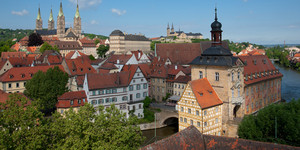
Bamberg, City of Culture
They must surely have felt it, those musicians from Prague, when they founded the Bamberg Symphony in 1946, with a little seed funding from local culture lovers. Spiritually, Bamberg and Prague are sisters, even if today they're very different in extent and, of course, even more so in political significance. When you stroll through modern Prague or Bamberg, you step not just on ancient stones but on history itself.
Both cities are European treasure-houses. Both are fortunate in looking back on far-sighted, culture-loving past rulers: Bamberg had Heinrich II, who dreamt of a 'Rome north of the Alps', and Prague, three centuries later, had Charles IV, with his equally utopian vision of a 'Capital of the 14th Century'.
And both cities were lucky in another sense, too. They were spared the worst excesses of World War Two – unlike Warsaw or Dresden. Prague, for instance, still has some eighty examples of Romanesque architecture, not to mention a wealth of testimonies in stone to the Gothic and Renaissance, the Baroque and Classical periods, and of course Art Nouveau. Bamberg is blessed with one of Germany's largest intact historical city centres, including over 1,500 individual monuments. It's no coincidence that both cities were included in UNESCO’s World Heritage List at about the same time, in the early 1990s.
One thing that distinguishes Bamberg as a city of culture from the Czech capital, is that it was always a city of art, architecture and science, more than of music. That changed with the founding of the Bamberg Symphony, which has long been Germany's cultural ambassador to the world. And a little over twenty years ago, the opening of the Concert Hall on the river Regnitz gave the Orchestra an acoustically outstanding home, just when its arrival as a world-class orchestra coincided with UNESCO’s recognition of historic Bamberg’s global importance.


